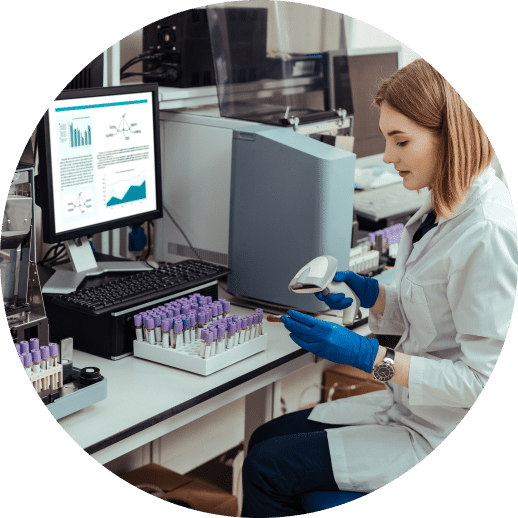Clinical Indication ID & Name
Monogenic diabetes
Test Group
Endocrinology
Specialties
Test code
R141.1
Test name
N/A
Target genes
Monogenic diabetes (472)
Test scope
n/a
Test method/ technology
WES or Medium Panel
Optimal Family Structure
n/a
Eligibility Criteria
1. Patients with isolated diabetes should be tested if they have:
a. Diabetes diagnosed young (≤35 years in White Europeans and ≤30 years in high prevalence ethnic groups).
AND
b. Unlikely to have Type 1 diabetes because:
They are not on insulin treatment.
OR
They are on insulin treatment with all autoantibodies tested negative (minimum testing of GADA and IA2A) and a random non-fasting C peptide value ≥200pmol/l
AND
c. Have features suggestive of MODY:
An HbA1c at diagnosis of diabetes <7.5% (58mmol/mol), if diagnosed under 18 years of age,
OR
BMI <30kg/m2 adult (child BMI <95th centile) and a parent with diabetes (if White) or BMI <27kg/m2
(child BMI <95th centile) and a parent with diabetes (if high prevalence type 2 diabetes ethnic group).
OR
Have a MODY probability score ≥20% if not insulin treated and ≥10% if insulin treated (see https://www.diabetesgenes.org/exeter-diabetes-app/ModyCalculator)
2. Syndromic diabetes: Patients with diabetes AND non-autoimmune extra-pancreatic features
• Diabetes diagnosed young
AND
• Unlikely to have type 1 diabetes (see 1b) or type 2 diabetes.
AND
• Non-autoimmune extra pancreatic features suggestive of syndromic monogenic diabetes
e.g.
• Cystic renal disease and/or congenital anomaly of kidney or urinary tract
• Bilateral sensorineural deafness
• Developmental delay
• Developmental defects
• Cardiomyopathy
• Optic atrophy
• Microcephaly
3. Diabetes with severe insulin resistance
• Patients have features of severe insulin resistance in the absence of obesity:
• Acanthosis nigricans
OR
• A fasting insulin >150pmol/l if not insulin treated OR if insulin treated an insulin requirement >3U/kg/day
AND
• Diabetes that is unlikely to be type 1 diabetes (see 1.0 above) or type 2
diabetes (BMI<30kg/m2 if white (<95th in children) or BMI <27kg/m2 (<95th in children) if high prevalence type 2 diabetes group).
Test code
R141.2
Test name
N/A
Target genes
GCK;HNF1A;HNF4A;HNF1B
Test scope
n/a
Test method/ technology
MPLA or equivalent
Optimal Family Structure
n/a
Eligibility Criteria
1. Patients with isolated diabetes should be tested if they have:
a. Diabetes diagnosed young (≤35 years in White Europeans and ≤30 years in high prevalence ethnic groups).
AND
b. Unlikely to have Type 1 diabetes because:
They are not on insulin treatment.
OR
They are on insulin treatment with all autoantibodies tested negative (minimum testing of GADA and IA2A) and a random non-fasting C peptide value ≥200pmol/l
AND
c. Have features suggestive of MODY:
An HbA1c at diagnosis of diabetes <7.5% (58mmol/mol), if diagnosed under 18 years of age,
OR
BMI <30kg/m2 adult (child BMI <95th centile) and a parent with diabetes (if White) or BMI <27kg/m2
(child BMI <95th centile) and a parent with diabetes (if high prevalence type 2 diabetes ethnic group).
OR
Have a MODY probability score ≥20% if not insulin treated and ≥10% if insulin treated (see https://www.diabetesgenes.org/exeter-diabetes-app/ModyCalculator)
2. Syndromic diabetes: Patients with diabetes AND non-autoimmune extra-pancreatic features
• Diabetes diagnosed young
AND
• Unlikely to have type 1 diabetes (see 1b) or type 2 diabetes.
AND
• Non-autoimmune extra pancreatic features suggestive of syndromic monogenic diabetes
e.g.
• Cystic renal disease and/or congenital anomaly of kidney or urinary tract
• Bilateral sensorineural deafness
• Developmental delay
• Developmental defects
• Cardiomyopathy
• Optic atrophy
• Microcephaly
3. Diabetes with severe insulin resistance
• Patients have features of severe insulin resistance in the absence of obesity:
• Acanthosis nigricans
OR
• A fasting insulin >150pmol/l if not insulin treated OR if insulin treated an insulin requirement >3U/kg/day
AND
• Diabetes that is unlikely to be type 1 diabetes (see 1.0 above) or type 2
diabetes (BMI<30kg/m2 if white (<95th in children) or BMI <27kg/m2 (<95th in children) if high prevalence type 2 diabetes group).
Commissioning group
Specialised
Overlapping idications
• R158 Lipodystrophy – childhood onset test should be used for congenital severe syndromic forms of lipodystrophy • R142 Glucokinase-related fasting hyperglycaemia test should be used for asymptomatic fasting hyperglycaemia
Address for samples/request forms
North Thames GLH, Rare & Inherited Disease Genomic Laboratory
Specimen Reception, Level 5 Barclay House, 37 Queen Square,
London WC1N 3BH
Contact with queries
Supporting documents
Rare Disese WGS Clinician pack
Education resources
n/a
Service updates
n/a
Request form download
Consent record
See consent guidance in test request form
Sample requirements
See sample guidance in test request form
